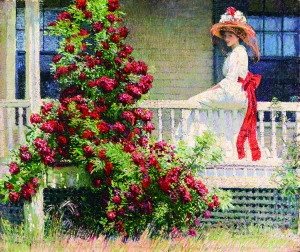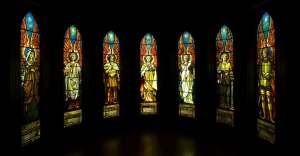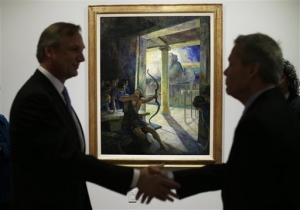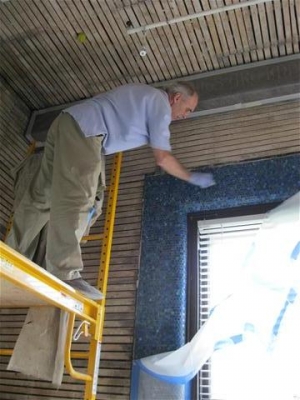|
Displaying items by tag: tiffany studios
Renowned for its collection of lamps by Tiffany Studios, the New York Historical Society on Central Park West will renovate the Henry Luce III Center for the Study of American Culture and dedicate the space to displaying the 100 lamps it owns.
Designed by architect Eva Jiřičná, the 3,000-square-foot, two-story space is scheduled to open in early 2017, and will feature the Tiffany lamps lit in a darkened gallery, creating a dramatic, glowing effect for visitors.
The collection, which was organized by The Neustadt Collection of Tiffany Glass in New York City, showcases works created by Tiffany Studios. The exhibition comes to Wilmington, Delaware, after a stop at the Kalamazoo Institute of Arts in Michigan. Dr. Ergon Neustadt, the founder of The Neustadt Collection, began acquiring Tiffany lamps in 1935. In 1967, he purchased the flat and pressed glass leftover from the 1930s Tiffany Studios closing. A display case of these bits of glass is also on view in the exhibit.
The colorful, stained-glass effect decor items produced by Tiffany Studios represent some of the most beautiful and quintessential specimens of pre-war design such as the Oriental Poppy lamp, which sold for $1.1 million at Sotheby’s in New York this past May. As a painter, Louis Comfort Tiffany was fascinated with the interplay of light and color, and using opalescent glass as his canvas, created masterful renderings of nature — such as flowers or landscape scenes — and decorative geometric patterns in lampshades and leaded-glass windows that popped with color and texture.
Louise Mirrer, President and CEO of the New-York Historical Society, today announced the appointment of curator Margaret K. Hofer to the role of Vice President and Director of its Museum division. Ms. Hofer has contributed to or overseen New-York Historical’s decorative arts collections and exhibitions for over two decades, and spearheaded the groundbreaking 2007 exhibition and publication A New Light on Tiffany: Clara Driscoll and the Tiffany Girls, which revealed previously unrecognized achievements of Tiffany Studios’ women designers.
Nearly a hundred examples of iconic Tiffany Studios works are forming the centerpiece of Sotheby’s sale of Tiffany and Prewar Design: The Warshawsky Collection in New York on May 19.
Led by the "Elaborate Peony" Lamp, circa 1910 (est. $600,000-$900,000), the variety of colorful glass works in mostly floral motifs is emblematic of the collection of noted Chicago businessman Roy Warshawsky and his wife Sarita, who assembled the works from the 1960s through the 1990s. There are also leaded glass lighting and windows, favrile glass, enamels, pottery, and bronze pieces produced by the firm founded by Louis Comfort Tiffany.

The national garden movement and, in particular, artists’ interest in gardens, has deep roots in Philadelphia, beginning with William Penn’s founding of his green and pleasant town in the seventeenth century and John Bartram’s establishing his botanical garden in 1728. In the early nineteenth century, artist Charles Wilson Peale retired to the cultivation of his garden at Belfield, and the Pennsylvania Horticultural Society was founded (in 1827), two years later hosting its first flower show. Interest gained momentum with the Colonial Revival movement, itself an outcome of Philadelphia’s 1876 Centennial Exhibition, and continued into the twentieth century.1 In her popular 1901 Colonial Revival-inspired publication Old Time Gardens, Alice Morse Earle wrote of Philadelphia: “There floriculture reached by the time of the Revolution a very high point, and many exquisite gardens bore ample testimony to the ‘pride of life,’ as well as to the good taste and love of flowers of Philadelphia Friends.” 2
Horticultural obsession also permeated the Philadelphia art scene. One of the most iconic conjunctions of art and the garden is the commissioning from Maxfield Parrish and Tiffany Studios of the fabulous Dream Garden (1913–1915, installed 1916) for the Curtis Building. The work was commissioned by Edward W. Bok (1863–1930), the head of Curtis Publishing, the influential publisher of Ladies Home Journal for the company’s new headquarters in Philadelphia.
Visit InCollect.com to read more about American Impressionism and the Garden Movement.

In 1964, Cincinnati’s Swedenborgian Church of the New Jerusalem was razed for the construction of a highway. The spiritual home to followers of the 18th-century Swedish scientist and theologian Emanuel Swedenborg, the church was built in 1902, at which time it received the gift of seven stained-glass windows produced by Tiffany Studios, the pre-eminent American producer of stained and art glass, under the direction of the firm’s founder and head, Louis Comfort Tiffany (1848-1933). Unlike many Tiffany windows that perished when their buildings faced the wrecking ball, these were preserved. For decades they sat in crates, hidden away in basements and garages of parishioners, and eventually a barn in Pennsylvania. Only when the barn began to leak in 2001 did a newly appointed minister open the crates. To her astonishment, that which was lost was found again—and even covered with decades of grime, the unique Tiffany beauty of all seven windows, each emblazoned with a life-size stained-glass angel, made a powerful impression.
The Lyman Allyn Art Museum in New London has acquired a one-of-a-kind Tiffany stained-glass window piece to ensure that it will be on display for public view.
The acclaimed Tiffany Studios of New York created “Come Unto Me,” which depicts Jesus Christ juxtaposed by a magnificent background landscape consisting of mountains, cypress trees and a lake.
The piece, signed by Louis Comfort Tiffany, is made entirely out of Favrille glass and was installed inside the All Souls Unitarian Universalist Church in New London in 1924.

On March 4, 2013 the Philadelphia Museum of Art announced a number of important acquisitions that will enhance the institution’s European, Latin, and American art collections. The gifts came from various donors including collectors Roberta and Richard Huber, global healthcare company GlaxoSmithKline, and several Museum Trustees.
Among the recent acquisitions is Amaryllis Josephine, a double-page watercolor on vellum by Belgian painter and botanist Pierre Joseph Redouté (1759-1840). A pencil drawing of the flower’s bulb accompanies the watercolor. Both of the works were created as part of a series of engravings made under the patronage of the empress Joséphine, Napoleon Bonaparte’s first wife.
The museum also received four 18th century paintings that are currently on view as part of the exhibition Journeys to New Worlds: Spanish and Portuguese Colonial Art from the Roberta and Richard Huber Collection (on view through May 19, 2013). The works include King Luis I of Spain on Horseback (unknown artist, Peru); Saint Anthony of Padua Preaching Before Pope Gregory IX (unknown artist Peru); The House at Nazareth (unknown artist, Bolivia); and Our Lady of the Reedbed or Irún with Donor, Captain Joaquín Elorrieta by Ecuadorian artist José Cortés de Alcocer.
Other acquisitions include 236 photographs by pioneering modern photographer Paul Strand (1890-1976); N.C. Wyeth’s (1890-1976) Trial of the Bow, the first painting to enter the museum’s collection by the artist; and an early 20th century stained glass and bronze chandelier by Tiffany Studios under the artistic direction of Louis Comfort Tiffany (1848-1933).
The Philadelphia Museum of Art will hold an exhibition of its recent acquisitions this summer.

The Tiffany Reading room located in Irvington, New York’s Town Hall opened this month after years of restoration. Designed by Louis Comfort Tiffany, the renowned artist, decorator, and glassmaker, the Tiffany Reading Room boasts lettering gilded in gold leaf, glass mosaics, and turtleback lanterns.
Louis Tiffany (1848-1933), the son of Tiffany & Co. founder, Charles Lewis Tiffany (1812-1902), was a long-time resident of both New York City and Irvington; an affluent suburb located just 20 miles north of midtown Manhattan. Charles Tiffany served as a trustee of Irvington’s Mental and Moral Improvement Society, which donated the land on which the Town Hall was built in 1892. The Society’s only stipulation was that the building should include a free reading room for the public’s enjoyment. In keeping with this request, Helen Gould, the daughter of railroad magnate Jay Gould, donated $10,000 to have the room designed by Louis Tiffany.
Once a majestic and beautifully decorated space, the Reading Room had fallen into disrepair by the late 1990s. Inspired by a letter from Tiffany’s great-grandson, Irvington residents formed the Tiffany Room Committee and embarked on a $280,000, eight-year-long restoration. The result of their efforts is a Reading Room that has been returned to its original grandeur, featuring restored mosaics and wall sconces and tables and chairs by Tiffany Studios.
|
|
|
|
|